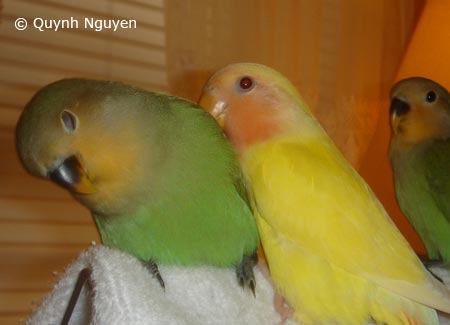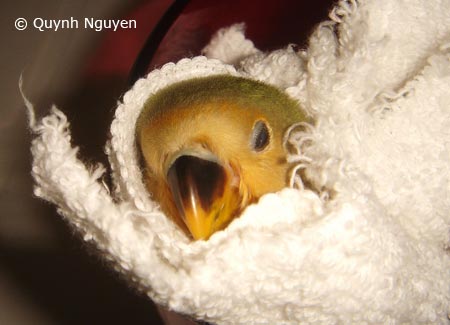Lovebird Breeding Supplies
Ever thought of breeding lovebirds? Many people have, especially enthusiasts that enjoy genetic mutations or handfed babies. It is very interesting to watch a pair of lovebirds cycle though breeding and produce healthy offspring. However, breeding lovebirds is an art as much as it is a hobby. Anyone can breed lovebirds but breeding healthy lovebirds takes work and commitments form both you and the parents.

Lovebird Breeding Supplies
Before breeding can begin the proper supplies will be needed. Having a good set of supplies will save you time and benefit the birds. It’s important to constantly update and throw out
old or damaged supplies. This keeps your routine running smoother and it is much safer for the birds. Below, several supplies are listed and their uses.
Emergency Supplies
Before breeding lovebirds several supplies will be needed. Why?
Well anything can happen during the breeding season such as a cracked
egg, a dry hatch, or an abandoned baby. It is important to be prepared
and read up on information to make yourself aware of the various
accidents or problems that can happen.
Brooders: Having a brooder is very important. If the pair abandons their babies the chicks will needed to be placed inside a brooder immediately. The temperature should be set to 95◦F if the babies are newborns and gradually dropped until the babies are fully feathered.
Thermometers: Two should be on hand. One should be placed inside the brooder and one should be used to measure the formula temperature. The formula needs to be between 106-108 degrees Fahrenheit.
Medicine Droppers: Medicine droppers and pipettes will be used to feed newborns for first feedings.
Unflavored Pedialyte: Pedialyte is a great substitute for water. Pedialyte should only be given the first week, until the digestive system is working properly.
Hand Feeding Formula: This can be your choice. Feeding formulas on the market are great and many are designed for optimal health. Just be sure to read the directions and specifications.
Tweezers: If an assisted hatch is needed, tweezers will be used to gently peel back the shell. Make sure they are sterile and properly stored.
Syringe/ Spoon: Syringes and spoons are needed to feed the checks as they mature.
Lovebird Housing Supplies

Cage: Choose an appropriate cage that can be cut or has a door made for an external nesting box. The doors should be able to accommodate food bowls, toys, and your hands. Perches should be placed away from food and water bowls. This will minimize droppings inside their dishes. The cage should have a grill to prevent the birds from touching or interacting with their droppings. Finally, the cage should be easy enough to dismantle after the breeding season for a proper cleaning.
Perches: Perches should be different sizes. This gives the birds exercise for their feet. If different sized perches cannot be found then natural tree branches can be used—eucalyptus, pine, or citrus branches are just a few. Please do research before other tree branches are used, as many plants and trees are toxic to birds.
Bedding: Most lovebirds construct their nest but bedding should be used as a barrier between the wood and the nest. This will make an easier cleanup after each clutch and add more cushion for the babies and eggs. Aspen Shavings or Carefresh are optimal choices.
Bleach Solution: This is very important. All equipment should be washed with this solution after each clutch. This ensures less harmful bacteria and healthier chicks. It is important to wash off breeding equipment with a bleach solution. The solution consists of 1 part bleach to 10 parts water.




